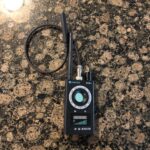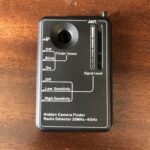Do consumer grade “Hidden Spy Detectors” for locating GPS Trackers, Listening Devices and Cameras really work?
Having done bug sweeps for over a decade, we often find that clients have already used these types of consumer grade anti spy devices found on Amazon and eBay for less than $100.00.  Unfortunately, most consumers attempting to do the bug sweep work themselves often don’t understand how electronic eavesdropping devices and anti-spy detectors work and are left feeling more vulnerable and paranoid due to the high number of false positives they receive when using consumer grade devices, and they may never have any kind of closure.
Unfortunately, most consumers attempting to do the bug sweep work themselves often don’t understand how electronic eavesdropping devices and anti-spy detectors work and are left feeling more vulnerable and paranoid due to the high number of false positives they receive when using consumer grade devices, and they may never have any kind of closure.
 The simple answer is these anti-spy devices don’t really work well unless you know how to:
The simple answer is these anti-spy devices don’t really work well unless you know how to:
- evaluate the high volume of false positives you will inevitably run across,
- how to properly use the anti-spy device and
- know how to determine what you should be looking for.
Most of these consumer grade anti-spy devices have only two components that would help in determining if a spy device is nearby. Both are very limited and unsophisticated and therefore inexpensive and sellable to most consumers. Let’s dive into the two components a little more:
- RF Signal Detector
This is commonly referred to as a “strong signal detector”, which is only one tool out of a dozen that a proper TSCM team would use to determine if there is a rogue electronic device operating in a target space.
A strong signal detector uses antennas designed for specific radio frequencies and is only going to locate the strongest signal in that range which is typically 20 MHz – 6 GHz. To complicate the matter when using a device such as this, especially in a signal rich environment like an apartment building or office building, where there may be hundreds of signals, it is only going to show the strongest signal in whatever range it is capable of. That signal may be on a floor below you, above you, in an adjacent room belonging to another tenet or even outside of the building.
Most radio frequencies a signal detector reacts to are going to be false positives or signals that the layman might not realize could be related to AM/FM radio, TVs, Bluetooth speakers, computers, internet, printers, cell phones, alarm systems, refrigerators or any number of smart devices common in our lives today. A strong signal detector will not help determine anything without other tools such as military grade spectrum analyzers that can clearly identify ALL radio frequency signals to eliminate false positives.
Another issue with this type of device is it’s only going to detect live signals. If a device uses data storage such as an SD card or hard drive and doesn’t transmit the data, then this anti-spy device will not locate the device.
Using a strong signal detector on a car to locate a hidden GPS is even more problematic. Vehicles built in the last 10 years all have computers, navigation systems (which include GPS), infotainment systems and thousands of sensors that would trigger an alert with a strong signal detector. Typically, many GPS devices designed to be hidden on vehicles only work when the vehicle is moving. When the vehicle is moving, all the vehicle sensors, navigation system and infotainment system would be active which would result in the device alerting you to those signals. The device is not going to tell you how many signals there are or what the signals are for.
If you attempt to examine the vehicle while it is parked and off, you may not get any alerts which doesn’t mean there isn’t a GPS hidden on the car because it may only trigger a signal when the car is moving at which point the signal is camouflaged by other signals.
- Camera Lens Finder
This feature is included on most of these consumer grade anti-spy devices. The red or blue tinted disc meant for the user to look through, is also only one tool of many that a professional sweep team may utilize. The lens finder is the most basic tool for a sweep and can be useful but only if the user knows what to look for. The user looks through the view finder and pushes a button to trigger a flashing light. The light will then reflect off anything that has a reflective surface such as glass, plastic or metal. Then, if the user sees something reflecting, they will then take a closer look with their own eyes to determine if it is indeed a camera lens or something else.
Nowadays, there are dozens of electronic components in any home, office or car that will exhibit the exact same characteristics as a device that is used for electronic eavesdropping. This leads to the user of such anti-spy devices observing alerts for radio frequencies that may have no bearing on determining a privacy threat.
If you have privacy concerns related to listening devices, hidden cameras or geo-tracking, please contact HPI to speak with a professional.